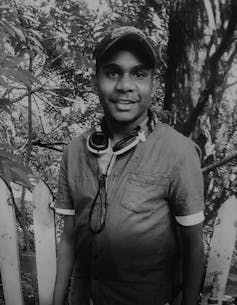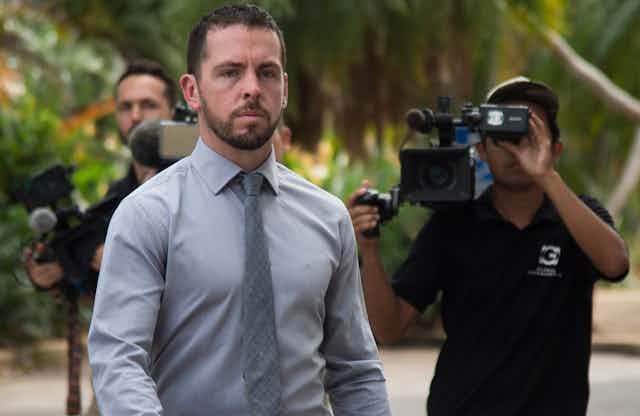This article contains information on deaths in custody, racist language and violence experienced by First Nations people in encounters with the Australian justice system. It also contains references to and the names of people who have passed away.
The three-month coronial inquest into Kumanjayi Walker’s death in police custody began on September 5 at the Alice Springs Local Court.
During an attempted arrest, 19-year-old Warlpiri teenager Kumanjayi Walker was fatally shot on November 9 2019 by Northern Territory police constable Zachary Rolfe. In March 2022, Rolfe was acquitted of murder, manslaughter and engaging in a violent act causing death.
Last week, the inquest heard details of several text messages between Rolfe and other members of the NT police, including officers in more senior positions than Rolfe.
The texts contain derogatory and racist comments about Aboriginal people.
Racism among police will come as little surprise to many Aboriginal and Torres Strait Islander people. Indeed, systemic racism is entrenched in Australia’s legal system.
Racist texts are relevant for this inquest
Rolfe’s lawyers had objected to the inclusion of text messages between police officers downloaded from his phone after his arrest. But this was rejected by Coroner Elisabeth Armitage, who ruled the text messages should be examined by the inquest as potential evidence of racism playing a “conscious or unconscious” role in Walker’s death.

That ruling was in contrast to Rolfe’s March 2022 trial, at which Supreme Court Justice John Burns ruled the text messages to be inadmissable.
In the opening week of the inquest, Peggy Dwyer, counsel assisting the coroner, said: “some of those text messages do suggest negative attitudes towards Aboriginal people that should and will cause great concern”.
Dwyer also stated the importance of understanding where these racist attitudes were coming from, and if there was a way to prevent them, asking: “Is there a risk that if we don’t, those attitudes may lead again to deadly confrontation?”
Racist attitudes from police are nothing new
Despite the media attention these racist text exchanges are now receiving, such racism is far from an isolated incident.
More than 30 years after the Royal Commission into Aboriginal Deaths in Custody, systemic racism remains entrenched in the Australian legal system. Systemic racism refers to colonial structures that perpetuate white racial superiority across institutions, laws, police and practices which continue to disadvantage Aboriginal and Torres Strait Islander people.
More than 500 Aboriginal and/or Torres Strait Islander people have died in custody since the Royal Commission into Aboriginal Deaths in Custody. No one has been held criminally responsible for any of these deaths.
Read more: Explainer: what is systemic racism and institutional racism?
Police racially targeting Aboriginal people does not just happen in the NT. In Melbourne in 2020, Korey Penny said he was violently thrown from his bicycle by police who subjected him to foulmouthed racist abuse. Although it was reported Penny is pursuing court action, it’s unknown whether he has reached an outcome.
In the same year, three South Australian police officers were filmed violently arresting a 28-year-old Aboriginal man. And just last week, a 14-year-old Aboriginal boy was taken to hospital in New South Wales with lacerations to his head. The boy’s family allege the head injuries were caused by the violent arrest and excessive use of force by police.
Holding police accountable for violence, excessive use of force and systemic racism must involve an active approach to addressing police culture and dehumanising behaviours. The current investigative process, in which police conduct internal investigations of wrongdoing, is simply not working. The oversight of an external global body into systemic racism and police would be best placed, rather than police investigating police.
However, this coronial inquest is at least an improvement on internal police investigations, as the investigative process involves Walker’s family members’ questions being answered, and keeps them informed as far as practicable.
The acceptance and dismissal of racist language makes it easier for discriminatory behaviour to continue. Addressing systemic racism must go beyond further training and education for police.
Until colonial governments acknowledge the existence of systemic racism and are held accountable for it, Aboriginal people will never see just outcomes.

